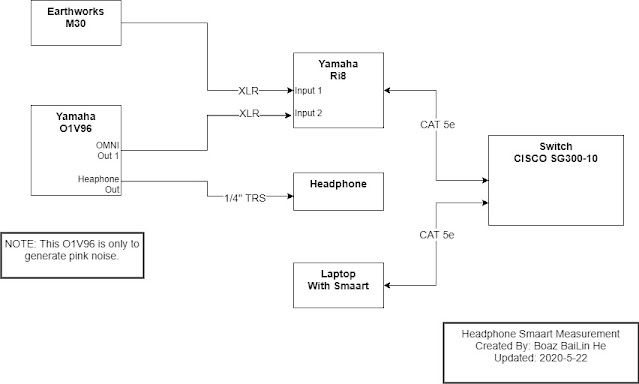Smaart Measurement for My Headphones
My first sound class was in 2016 at New York City College of Technology, that was also the first time I buy an over-ear headphone for monitor and editing. I brought a HAS-10 from Lyx Pro. I brought it because I saw that they advertise it's a pair of monitor headphone. I did email Lyxpro for a frequency response chart of the headphone, but they never send that to me. So I was wondering if I could do a measurement of the headphone myself to find out the frequency response. During that time I just start to learn about audio, and I didn't hear about transfer function. Not until 2017, I took the sound system class. That's the first time I hear about transfer function and Smaart. In 2018 I took the Smaart fundamentals class. That's the time I learn how to do a frequency response measurement. Enough storytime, here is the measurement I got for my headphones.
I did the measurement using Smaart V8. I used a Yamaha O1V96 to generate pink noise, sent to a Yamaha Ri8. I used the Earthworks M30 as the measurement microphone. Both the reference signal, and measurement signal are sent to the Ri8, then sent to a laptop with Smaart through Dante.
This is the photo and the measurement for the Lyxpro HAS-10 headphone. I use it for all my class projects, since I can't use speakers in a school lab that has other students. It did satisfy what I need for my classes. When I see the measurement, I was a little surprised, when I saw there is a huge difference in the mid-range frequency. That boost around 2k Hz is what I hear all these years in college.
My friend gave me a pair of headphone on my birthday last year (2019). It's a pair of Status CB1 closed-back headphone. I only get it for a short amount of time, so I didn't get a chance to use it on any real project yet. I did use it to listen to music. It sounded pretty balance. The measurement below prove that. The CB1 has a lesser difference between each octave compare to HAS-10. I'm not sure why there is a big drop around 16k Hz.
Both headphones are shy at the low frequency. Which is normal for headphones. The size of the driver inside headphones is not able to produce enough low frequency. The photo below can prove that.
I know mix only using headphones is a good idea. Since the low frequency can't produce correctly. But when mixing live is good to have a pair of headphone to monitor and troubleshoot.








Comments
Post a Comment